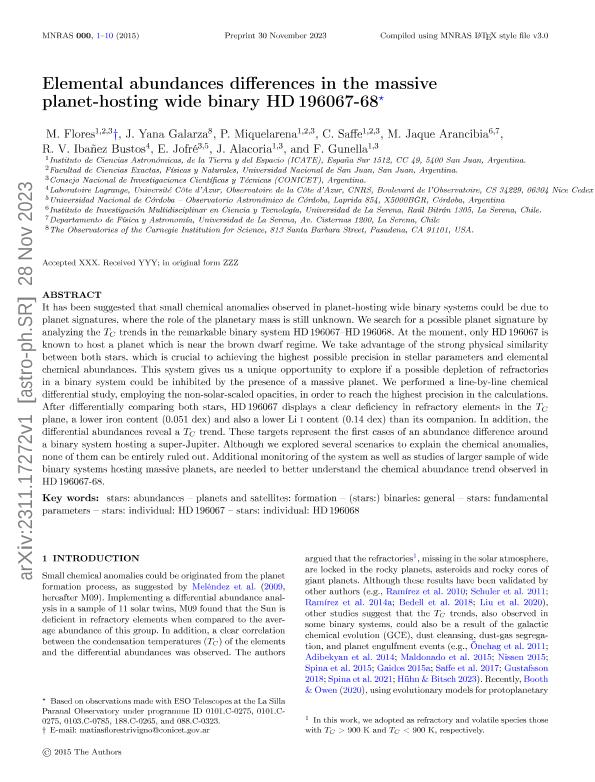Mostrar el registro sencillo del ítem
dc.contributor.author
Flores, Matias
dc.contributor.author
Galarza, J. Yana
dc.contributor.author
Miquelarena Hollger, Paula Andrea

dc.contributor.author
Saffe, Carlos

dc.contributor.author
Arancibia, M. Jaque
dc.contributor.author
Ibañez Bustos, Romina Valeria

dc.contributor.author
Jofre, Jorge Emiliano

dc.contributor.author
Alacoria, José Alberto

dc.contributor.author
Gunella Toledo, Jose Fernando

dc.date.available
2024-01-05T15:12:21Z
dc.date.issued
2023-12
dc.identifier.citation
Flores, Matias; Galarza, J. Yana; Miquelarena Hollger, Paula Andrea; Saffe, Carlos; Arancibia, M. Jaque; et al.; Elemental abundances differences in the massive planet-hosting wide binary HD 196067-68; Wiley Blackwell Publishing, Inc; Monthly Notices of the Royal Astronomical Society; 12-2023
dc.identifier.issn
0035-8711
dc.identifier.uri
http://hdl.handle.net/11336/222630
dc.description.abstract
It has been suggested that small chemical anomalies observed in planet-hosting wide binary systems could be due to planet signatures, where the role of the planetary mass is still unknown. We search for a possible planet signature by analyzing the TC trends in the remarkable binary system HD 196067–HD 196068. At the moment, only HD 196067 is known to host a planet which is near the brown dwarf regime. We take advantage of the strong physical similarity between both stars, which is crucial to achieving the highest possible precision in stellar parameters and elemental chemical abundances. This system gives us a unique opportunity to explore if a possible depletion of refractories in a binary system could be inhibited by the presence of a massive planet. We performed a line-by-line chemical differential study, employing the non-solar-scaled opacities, in order to reach the highest precision in the calculations. After differentially comparing both stars, HD 196067 displays a clear deficiency in refractory elements in the TC plane, a lower iron content (0.051 dex) and also a lower Li i content (0.14 dex) than its companion. In addition, the differential abundances reveal a TC trend. These targets represent the first cases of an abundance difference around a binary system hosting a super-Jupiter. Although we explored several scenarios to explain the chemical anomalies, none of them can be entirely ruled out. Additional monitoring of the system as well as studies of larger sample of wide binary systems hosting massive planets, are needed to better understand the chemical abundance trend observed in HD 196067-68.
dc.format
application/pdf
dc.language.iso
eng
dc.publisher
Wiley Blackwell Publishing, Inc

dc.rights
info:eu-repo/semantics/openAccess
dc.rights.uri
https://creativecommons.org/licenses/by-nc-sa/2.5/ar/
dc.subject
STARS: ABUNDANCES
dc.subject
STARS: BINARIES: GENERAL
dc.subject
STARS: FUNDAMENTAL PARAMETERS
dc.subject
STARS: INDIVIDUAL: HD 196067-68
dc.subject.classification
Astronomía

dc.subject.classification
Ciencias Físicas

dc.subject.classification
CIENCIAS NATURALES Y EXACTAS

dc.title
Elemental abundances differences in the massive planet-hosting wide binary HD 196067-68
dc.type
info:eu-repo/semantics/article
dc.type
info:ar-repo/semantics/artículo
dc.type
info:eu-repo/semantics/publishedVersion
dc.date.updated
2024-01-04T14:56:49Z
dc.journal.pais
Reino Unido

dc.journal.ciudad
Londres
dc.description.fil
Fil: Flores, Matias. Consejo Nacional de Investigaciones Científicas y Técnicas. Centro Científico Tecnológico Conicet - San Juan. Instituto de Ciencias Astronómicas, de la Tierra y del Espacio. Universidad Nacional de San Juan. Instituto de Ciencias Astronómicas, de la Tierra y del Espacio; Argentina
dc.description.fil
Fil: Galarza, J. Yana. Carnegie Observatories; Estados Unidos
dc.description.fil
Fil: Miquelarena Hollger, Paula Andrea. Consejo Nacional de Investigaciones Científicas y Técnicas. Centro Científico Tecnológico Conicet - San Juan. Instituto de Ciencias Astronómicas, de la Tierra y del Espacio. Universidad Nacional de San Juan. Instituto de Ciencias Astronómicas, de la Tierra y del Espacio; Argentina
dc.description.fil
Fil: Saffe, Carlos. Consejo Nacional de Investigaciones Científicas y Técnicas. Centro Científico Tecnológico Conicet - San Juan. Instituto de Ciencias Astronómicas, de la Tierra y del Espacio. Universidad Nacional de San Juan. Instituto de Ciencias Astronómicas, de la Tierra y del Espacio; Argentina
dc.description.fil
Fil: Arancibia, M. Jaque. Universidad de La Serena; Chile
dc.description.fil
Fil: Ibañez Bustos, Romina Valeria. Observatoire de la Cote D'Azur; Francia. Centre National de la Recherche Scientifique; Francia. Consejo Nacional de Investigaciones Científicas y Técnicas; Argentina
dc.description.fil
Fil: Jofre, Jorge Emiliano. Universidad Nacional de Córdoba. Observatorio Astronómico de Córdoba; Argentina. Consejo Nacional de Investigaciones Científicas y Técnicas. Centro Científico Tecnológico Conicet - Córdoba; Argentina
dc.description.fil
Fil: Alacoria, José Alberto. Consejo Nacional de Investigaciones Científicas y Técnicas. Centro Científico Tecnológico Conicet - San Juan. Instituto de Ciencias Astronómicas, de la Tierra y del Espacio. Universidad Nacional de San Juan. Instituto de Ciencias Astronómicas, de la Tierra y del Espacio; Argentina
dc.description.fil
Fil: Gunella Toledo, Jose Fernando. Consejo Nacional de Investigaciones Científicas y Técnicas. Centro Científico Tecnológico Conicet - San Juan. Instituto de Ciencias Astronómicas, de la Tierra y del Espacio. Universidad Nacional de San Juan. Instituto de Ciencias Astronómicas, de la Tierra y del Espacio; Argentina
dc.journal.title
Monthly Notices of the Royal Astronomical Society

dc.relation.alternativeid
info:eu-repo/semantics/altIdentifier/url/https://academic.oup.com/mnras/advance-article/doi/10.1093/mnras/stad3714/7459956
dc.relation.alternativeid
info:eu-repo/semantics/altIdentifier/doi/http://dx.doi.org/10.1093/mnras/stad3714
Archivos asociados
